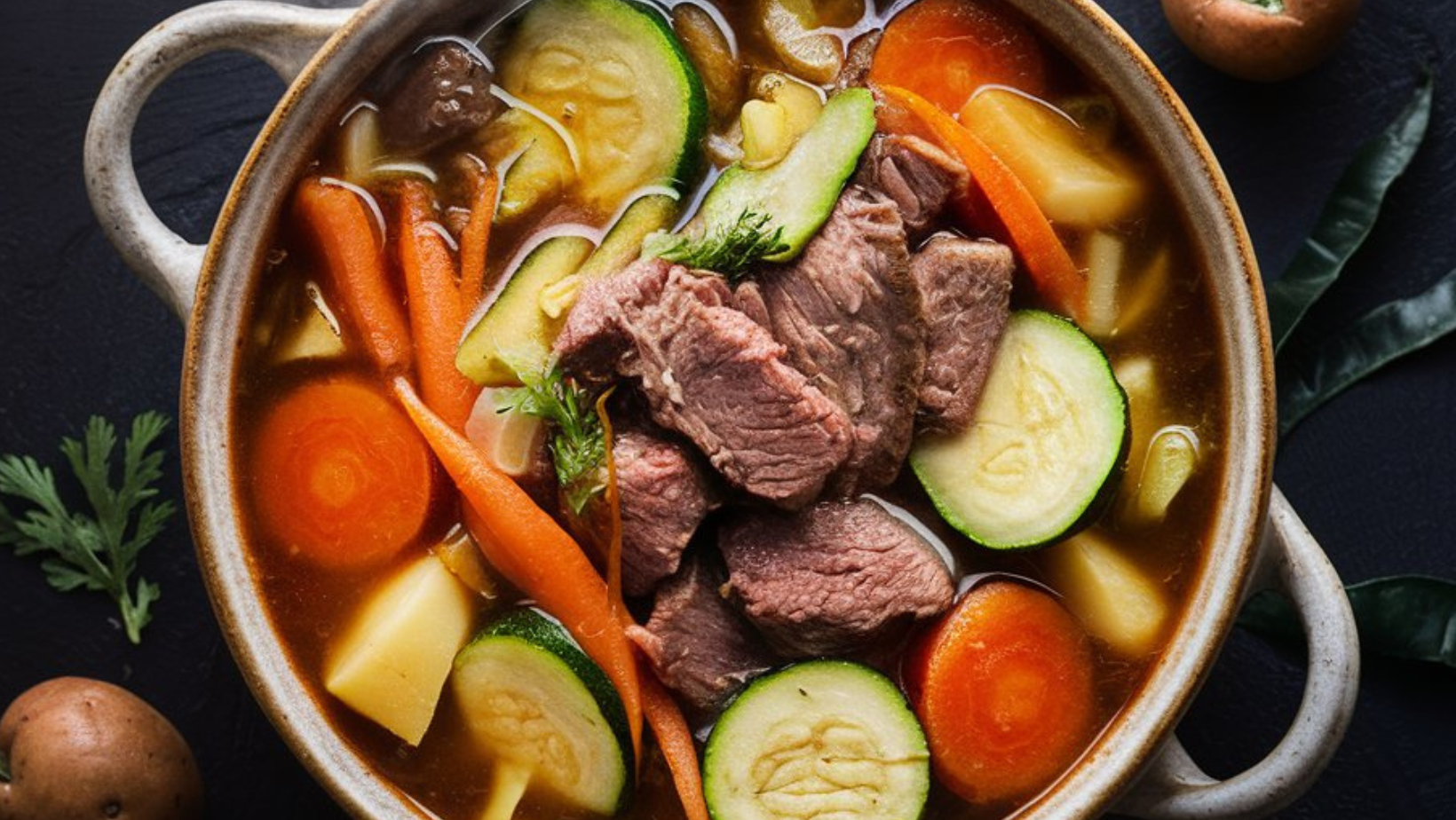Introduction to Caldo de Res
What Goes into Caldo de Res?
Caldo de Res isn’t just a feast for the taste buds; it’s a concoction brimming with nutritious ingredients that beg a closer look. Typically, this soup features a robust blend of beef shank or brisket, corn, carrots, potatoes, and sometimes cabbage or zucchini. Each ingredient doesn’t just add flavor; they bring a host of vitamins and minerals to the table.
Nutritional Content of Key Ingredients
Diving deeper, the beef in Caldo de Res is a fantastic source of protein and essential minerals like iron and zinc, crucial for maintaining good health. The vegetables are no slouch either; they’re loaded with dietary fiber, which aids digestion, and vitamins such as Vitamin A from carrots and Vitamin C from potatoes. Together, these components make Caldo de Res not only delicious but also incredibly nutritious.
By understanding what goes into Caldo de Res, it becomes clear why this dish is more than just comfort food. It’s a healthful blend that provides essential nutrients while satisfying hunger, making it a fantastic option for anyone looking to enrich their diet with traditional Mexican cuisine.
Analyzing the Nutritional Content
Calories, Vitamins, and Minerals
Caldo de Res is a powerhouse when it comes to its nutritional profile. A typical serving is rich in vitamins and minerals that are essential for overall health. For instance, the beef used in the soup is not only a great source of protein but also provides vitamin B12, crucial for brain health and maintaining healthy blood cells. The assortment of vegetables adds a burst of vitamins A and C, enhancing immunity and vision.
Macronutrients – Proteins, Fats, and Carbohydrates
The macronutrient balance in Caldo de Res makes it a rounded meal. With protein from the beef, carbohydrates from vegetables like potatoes and corn, and a moderate amount of fats, primarily from the meat, this dish can certainly fit into a balanced diet. However, it’s important to consider the cuts of meat used, as leaner cuts can significantly reduce fat content, making the soup a healthier choice.
By highlighting the caloric and macronutrient content, we see how Caldo de Res serves not only as a satisfying meal but also supports a healthy diet. With each spoonful, you’re nourishing your body with essential nutrients, proving that this traditional dish can be both indulgent and beneficial.
Potential Health Concerns
Sodium Content and Its Impact
While Caldo de Res offers numerous health benefits, it’s also wise to be mindful of its sodium content. Traditional recipes may include added salt or high-sodium broth bases, which can pose a challenge for those monitoring their sodium intake. High sodium levels can lead to increased blood pressure and cardiovascular risk, making it important for consumers to modify recipes by using low-sodium broths or adjusting the amount of added salt.
Considerations for Fatty Cuts of Meat
Additionally, the choice of meat in Caldo de Res can influence the overall healthiness of the dish. Fatty cuts of beef, while flavorful, add saturated fats to the meal, which can impact heart health if consumed in excess. Opting for leaner cuts or trimming excess fat before cooking can make a significant difference, aligning the dish more closely with health-conscious eating habits.
How to Make Caldo de Res Healthier
For those looking to enjoy Caldo de Res as part of a healthier diet, several adjustments can be made. Incorporating more vegetables can increase fiber and nutrient content while reducing the proportion of meat. Additionally, using herbs and spices for flavoring instead of salt can help manage sodium levels without sacrificing taste.
By considering these factors, diners can enjoy Caldo de Res in a way that fits their health needs without giving up the flavors they love. Making mindful choices about ingredients and preparation methods can transform this traditional dish into a heart-healthy meal suitable for any table. It provides a broader look at how typical Mexican ingredients contribute to health, supporting the nutritional claims about the vegetables in Caldo de Res.
Caldo de Res in Various Diets
Suitability for Gluten-Free Diets
Caldo de Res naturally fits well within a gluten-free diet, as the primary ingredients—meat, vegetables, and broth—are inherently free of gluten. However, individuals with celiac disease or gluten sensitivity need to ensure that all broth used is certified gluten-free, as some commercial broths can contain gluten-containing additives.
Is Caldo de Res Keto-Friendly?
For those following a ketogenic diet, Caldo de Res can be adapted to fit this low-carb, high-fat dietary regime. By focusing on increasing the meat and high-fat ingredients like bone marrow and reducing higher-carb vegetables like potatoes and corn, Caldo de Res can become a keto-friendly option. Additionally, incorporating more leafy greens or non-starchy vegetables can further align this dish with keto dietary requirements.
Vegan Adaptations of Caldo de Res
Transforming Caldo de Res into a vegan-friendly dish involves substituting beef with plant-based proteins such as mushrooms or tofu, which can mimic the texture and heartiness of meat. Using vegetable broth and an array of vegetables enhances the dish’s flavor profile while keeping it entirely plant-based.
Through these adaptations, Caldo de Res proves to be a versatile dish that can accommodate various dietary needs, from gluten-free to keto to vegan diets. Each modification allows different dietary groups to enjoy the rich, comforting qualities of Caldo de Res while adhering to their nutritional preferences and requirements.
Frequently Asked Questions
Can Caldo de Res be considered a low-calorie food?
Caldo de Res can be low in calories, especially with lean meat and lots of vegetables. The calorie count depends on the ingredients and serving sizes, so it’s adaptable for calorie-controlled diets.
How can I reduce the sodium in Caldo de Res?
To lower the sodium in Caldo de Res, use low-sodium beef broth or make your own to control salt levels. Seasoning with herbs and spices instead of salt also enhances flavor without adding sodium.
What are the best cuts of meat for Caldo de Res for maximum health benefits?
For health benefits, choose lean beef cuts like sirloin or round. These cuts reduce saturated fat intake while providing essential nutrients. Including bone-in cuts adds flavor and nutrition, such as collagen, which supports joint and bone health.
These FAQs address common concerns about the health aspects of Caldo de Res, offering practical tips for enjoying this traditional dish in the healthiest way possible.
Conclusion
Caldo de Res is a staple in Mexican cuisine. It offers a comforting taste and a variety of health benefits. This dish provides rich protein and a wealth of vitamins and minerals from its vegetables. It can be a beneficial part of any nutritious diet. However, healthily enjoying Caldo de Res depends on how it’s prepared and the ingredients used.
To maximize health benefits, choose lean cuts of meat and add more vegetables. Also, be careful with salt to keep sodium levels low. By making these changes, Caldo de Res becomes a heart-healthy meal. It satisfies both taste and nutritional needs.
Incorporating Caldo de Res into your diet offers a taste of Mexican tradition and robust nutrition. Whether you savor it on a chilly day or include it regularly, this dish is more than comfort food. It’s comfort food that supports a healthy lifestyle.

